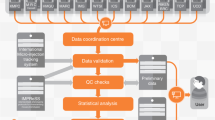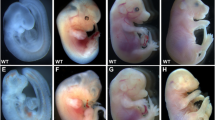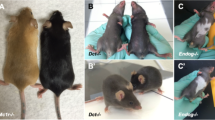Abstract
Complex nonadditive interactions between specific alleles at multiple loci may underlie many so-called multifactorial threshold birth defects. The open-eyelids-at-birth defect in mice is a good model for these defects, and an understanding of its genetic complexity begins with mapping the participating loci. The open-eyelids defect can be part of a syndrome or can occur with no other obvious phenotypic effects. Of the latter nonsyndromic forms, the lidgap series includes four extant mutations that are considered to be alleles based on complementation tests. All show genetic complexity in segregation ratios. None has been mapped previously. On the basis of a strategy of mapping the mutation with the simplest inheritance pattern first, we generated an extensive exclusion map for lidgap-Gates, lg Ga, using morphological and protein polymorphisms. We then screened the non-excluded regions in a congenic strain, AEJ.LGG—lg Ga, for SSLP markers and located the differential chromosome segment containing the lg Ga locus in a region near the distal end of mouse Chromosome (Chr) 13. This linkage was confirmed and refined by typing SSLPs in 64 F2 and 74 BC1 progeny of a cross of LGG/Bc (lg Ga/lg Ga) to SWV/Bc. The lg Ga mutation maps to a 1- to 2-cM region between D13Mit76 and D13Mit53. Integrin alpha 1 and integrin alpha 2, which map to the same general region, are possible candidate loci, based on their embryonic expression and cellular function. Evidence is also presented for a common unlinked recessive suppressor of the open eyelids trait caused by lg Ga.
Similar content being viewed by others

References
Ball, S.T., Peters, J. (1989). Koala, a dominant mutation. Mouse News Lett. 83, 163–164.
Balling, R., Mutter, G., Gruss, P., Kessel, M. (1989). Craniofacial abnormalities induced by ectopic expression of the homeobox gene Hox-1.1 in transgenic mice. Cell 58, 337–347.
Dietrich, W.F., Miller, J.C., Steen, R.G., Merchant, M., Damron, D., Nahf, R., Gross, A., Joyce, D.C., Wessel, M., Dredge, R.D., Marquis, A., Stein, L.D., Goodman, N., Page, D.C., Lander, E.S. (1994). A genetic map of the mouse with 4,006 simple sequence length polymorphisms. Nature Genet. 7, 220–245.
Findlater, G.S., McDougall, R.D., Kaufman, M.H. (1993). Eyelid development, fusion and subsequent reopening in the mouse. J. Anat. 183, 121–129.
Flaherty, L. (1981). Congenic strains. In The Mouse in Biomedical Research, Volume I, H.L. Foster, J.D. Small, J.G. Fox, eds. (New York: Academic Press), pp. 215–222.
Fraser, F.C., Nora, J.J. (1986). Genetics of Man. (Philadelphia: Lea & Febiger), p. 177.
Gates, A.H. (1968). New mutations. Mouse News Lett. 39, 37.
Glukhova, M.A., Thiery, J.P. (1993). Fibronectin and integrins in development. Semin. Cancer Biol. 4, 241–249.
Green, E.L. (1975). Breeding systems. In Biology of the Laboratory Mouse, Second Edition, E.L. Green, ed. (New York: Dover Publications Inc.), pp. 11–22.
Harris, M.J. (1989). Cortisone cure of the eyelid closure defect in lidgapStein fetal mice: a dose-response and time-response study as a test of the hypomorph hypothesis for the lidgap alleles. Teratology 39, 601–609.
Harris, M.J., Juriloff, D.M. (1986). Eyelid development and fusion induced by cortisone treatment in mutant, lidgap-Miller, foetal mice. A scanning electron microscope study. J. Embryol. Exp. Morphol. 91, 1–18.
Harris, M.J., McLeod, M.J. (1982). Eyelid growth and fusion in fetal mice. Anat. Embryol. 164, 207–220.
Harris, M.W., Fraser, F.C. (1968). Lid gap in newborn mice: a study of its cause and prevention. Teratology 1, 417–424.
Juriloff, D.M. (1987). Maternal treatment with cortisone accelerates eyelid closure and other developmental fusion processes in fetal mice. Development 100, 611–618.
Juriloff, D.M., Harris, M.J. (1984). Research news: the lidgaps. Mouse News Lett. 70, 66–68.
Juriloff, D.M., Harris, M.J. (1988a). Lidgap in mice: genetic models of developmental threshold traits. Genome 30, Suppl. 1, 183.
Juriloff, D.M., Harris, M.J. (1988b). Cleft palate: more genetic lessons from mice. J. Craniofac. Genet. Dev. Biol. 8, 127–134.
Juriloff, D.M., Harris M.J. (1989). A scanning electron microscope study of fetal eyelid closure accelerated by cortisone in SWV/Bc mice. Teratology 40, 59–66.
Juriloff, D.M., Harris, M.J. (1993). Retinoic acid, cortisone, or thyroxine suppresses the mutant phenotype of the eyelid development mutation, lg Ml, in mice. J. Exp. Zool. 265, 144–152.
Juriloff, D.M., Harris, M.J., Miller, J.R. (1983). The lidgap defect in mice: update and hypotheses. Can. J. Genet. Cytol. 25, 246–254.
Juriloff, D.M., Mah, D.G. (1995). The major locus for multifactorial non-syndromic cleft lip maps to mouse Chromosome 11. Mamm. Genome 6, 63–69.
Juriloff, D.M., Harris, M.J., Mah, D.G. (1994). Mapping Far (First arch) in relation to molecular markers on mouse Chromosome 2. Mamm. Genome 5, 450–452.
Justice, M.J., Stephenson, D.A. (1996). Mouse Chromosome 13. Mamm. Genome 6(Suppl.), in press.
Kelton, D.E., Rauch, H. (1968). Linkage of open eyelids with linkage group VII of the mouse. J. Hered. 59, 27–28.
Luetteke, N.C., Qiu, T.H., Peiffer, R.L., Oliver, P., Smithies, O., Lee, D.C. (1993). TGFα deficiency results in hair follicle and eye abnormalities in targeted and waved-1 mice. Cell 73, 262–278.
Luetteke, N.C., Phillips, H.K., Qiu, T.H., Copeland, N.G., Earp, H.S., Jenkins, N.A., Lee, D.C. (1994). The mouse waved-2 phenotype results from a point mutation in the EGF receptor tyrosine kinase. Genes & Dev. 8, 399–413.
Lyon, M.F., Searle, A.G. (1989). Genetic Variations and Strains of the Laboratory Mouse, 2nd ed. (New York: Oxford University Press).
Mann, G.B., Fowler, K.J., Gabriel, A., Nice, E.C., Williams, R.L., Dunn, A.R. (1993). Mice with a null mutation of the TGFα gene have abnormal skin architecture, wavy hair, and curly whiskers and often develop corneal inflammation. Cell 73, 249–261.
McPherson, J.D., LeBeau, M. (1994). Report of the committee on the genetic constitution of Chromosome 5. In Human Gene Mapping, 1993, A.J. Cuticchia, P.L. Pearson, eds. (Baltimore: Johns Hopkins University Press), pp. 280–301.
Mock, B.A., Eppig, J.T., Neumann, P.E., Huppi, K.E. (1994). Mouse Chromosome 15. Mammalian Genome 5(Suppl.), S217-S228.
Pearson, A.A. (1980). The development of the eyelids. Part I. External Features. J. Anat. 130, 33–42.
Peters, J., Cocking, Y. (1994). Mouse gene list. Mouse Genome 92, 169–299.
Sokal, R.R., Rohlf, F.J. (1969). Biometry. (San Francisco: W.H. Freeman).
Stein, K.F., Kettyle, C.N. (1973). Further data on the slit-lid mutant in mice and the effect of cortisone and doca on its development. Teratology 8, 51–54.
Stepp, M.A., Zhu, L., Sheppard, D., Cranfill, R.L. (1995). Localized distribution of α9 integrin in the cornea and changes in expression during corneal epithelial cell differentiation. J. Histochem. Cytochem. 43, 353–362.
Author information
Authors and Affiliations
Rights and permissions
About this article
Cite this article
Juriloff, D.M., Harris, M.J., Mah, D.G. et al. The lidgap-Gates (lg Ga) mutation for open eyelids at birth maps to mouse Chromosome 13. Mammalian Genome 7, 403–407 (1996). https://doi.org/10.1007/s003359900121
Received:
Accepted:
Issue Date:
DOI: https://doi.org/10.1007/s003359900121



